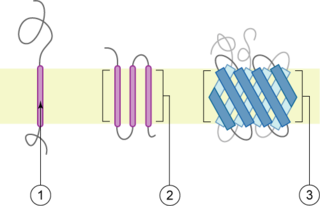Related Research Articles

Cotransporters are a subcategory of membrane transport proteins (transporters) that couple the favorable movement of one molecule with its concentration gradient and unfavorable movement of another molecule against its concentration gradient. They enable cotransport and include antiporters and symporters. In general, cotransporters consist of two out of the three classes of integral membrane proteins known as transporters that move molecules and ions across biomembranes. Uniporters are also transporters but move only one type of molecule down its concentration gradient and are not classified as cotransporters.
The Na-K-Cl cotransporter (NKCC) is a protein that aids in the secondary active transport of sodium, potassium, and chloride into cells. In humans there are two isoforms of this membrane transport protein, NKCC1 and NKCC2, encoded by two different genes. Two isoforms of the NKCC1/Slc12a2 gene result from keeping or skipping exon 21 in the final gene product.

The sodium-chloride symporter (also known as Na+-Cl− cotransporter, NCC or NCCT, or as the thiazide-sensitive Na+-Cl− cotransporter or TSC) is a cotransporter in the kidney which has the function of reabsorbing sodium and chloride ions from the tubular fluid into the cells of the distal convoluted tubule of the nephron. It is a member of the SLC12 cotransporter family of electroneutral cation-coupled chloride cotransporters. In humans, it is encoded by the gene SLC12A3 (solute carrier family 12 member 3) located in 16q13.
The sodium/phosphate cotransporter is a member of the phosphate:Na+ symporter (PNaS) family within the TOG Superfamily of transport proteins as specified in the Transporter Classification Database (TCDB).

Sodium/glucose cotransporter 1 (SGLT1) also known as solute carrier family 5 member 1 is a protein in humans that is encoded by the SLC5A1 gene which encodes the production of the SGLT1 protein to line the absorptive cells in the small intestine and the epithelial cells of the kidney tubules of the nephron for the purpose of glucose uptake into cells. Through the use of the sodium glucose cotransporter 1 protein, cells are able to obtain glucose which is further utilized to make and store energy for the cell.

Peptide transporter 1 also known as solute carrier family 15 member 1 (SLC15A1) is a protein that in humans is encoded by SLC15A1 gene. PepT 1 is a solute carrier for oligopeptides. It functions in renal oligopeptide reabsorption and in the intestines in a proton dependent way, hence acting like a cotransporter.

Sodium–hydrogen antiporter 3 also known as sodium–hydrogen exchanger 3 (NHE3) or solute carrier family 9 member 3 (SLC9A3) is a protein that in humans is encoded by the SLC9A3 gene.

WNK , also known as WNK1, is an enzyme that is encoded by the WNK1 gene. WNK1 is serine-threonine kinase and part of the "with no lysine/K" kinase WNK family. The predominant role of WNK1 is the regulation of cation-Cl− cotransporters (CCCs) such as the sodium chloride cotransporter (NCC), basolateral Na-K-Cl symporter (NKCC1), and potassium chloride cotransporter (KCC1) located within the kidney. CCCs mediate ion homeostasis and modulate blood pressure by transporting ions in and out of the cell. WNK1 mutations as a result have been implicated in blood pressure disorders/diseases; a prime example being familial hyperkalemic hypertension (FHHt).

Electrogenic sodium bicarbonate cotransporter 1 (NBCe1) is a membrane transport protein that in humans is encoded by the 'SLC4A4' gene.

Ileal sodium/bile acid cotransporter, also known as apical sodium–bile acid transporter (ASBT) and ileal bile acid transporter (IBAT), is a bile acid:sodium symporter protein that in humans is encoded by the SLC10A2 gene.

Potassium-chloride transporter, member 4 is a chloride potassium symporter protein. It is encoded by the gene SLC12A4.

Electroneutral sodium bicarbonate exchanger 1 is a protein that in humans is encoded by the SLC4A8 gene.

Sodium-dependent phosphate transport protein 2B (NaPi2b) is a protein that in humans is encoded by the SLC34A2 gene.

Sodium/myo-inositol cotransporter is a protein that in humans is encoded by the SLC5A3 gene.

Sodium-dependent phosphate transport protein 1 is a protein that in humans is encoded by the SLC17A1 gene.

Solute carrier family 13 member 3 also called sodium-dependent dicarboxylate transporter (NaDC3) is a protein that in humans is encoded by the SLC13A3 gene.

Solute carrier family 13 member 2 is a protein that is encoded in humans by the SLC13A2 gene.

The organic anion transporter 1 (OAT1) also known as solute carrier family 22 member 6 (SLC22A6) is a protein that in humans is encoded by the SLC22A6 gene. It is a member of the organic anion transporter (OAT) family of proteins. OAT1 is a transmembrane protein that is expressed in the brain, the placenta, the eyes, smooth muscles, and the basolateral membrane of proximal tubular cells of the kidneys. It plays a central role in renal organic anion transport. Along with OAT3, OAT1 mediates the uptake of a wide range of relatively small and hydrophilic organic anions from plasma into the cytoplasm of the proximal tubular cells of the kidneys. From there, these substrates are transported into the lumen of the nephrons of the kidneys for excretion. OAT1 homologs have been identified in rats, mice, rabbits, pigs, flounders, and nematodes.

It has been shown that integral membrane proteins that mediate the uptake of a wide variety of molecules with the concomitant uptake of sodium ions can be grouped, on the basis of sequence and functional similarities into a number of distinct families. One of these families is known as the sodium:dicarboxylate symporter family (SDF).
Divalent anion:Na+ symporters were found in bacteria, archaea, plant chloroplasts and animals.
References
- ↑ Markovich D, Forgo J, Stange G, Biber J, Murer H (September 1993). "Expression cloning of rat renal Na+/SO4(2-) cotransport". Proc. Natl. Acad. Sci. U.S.A. 90 (17): 8073–7. doi:10.1073/pnas.90.17.8073. PMC 47290 . PMID 7690140.
- ↑ Pajor AM (April 1996). "Molecular cloning and functional expression of a sodium-dicarboxylate cotransporter from human kidney". Am. J. Physiol. 270 (4 Pt 2): F642-8. doi:10.1152/ajprenal.1996.270.4.F642. PMID 8967342.
- ↑ Davies JP, Yildiz FH, Grossman A (May 1996). "Sac1, a putative regulator that is critical for survival of Chlamydomonas reinhardtii during sulfur deprivation". EMBO J. 15 (9): 2150–9. doi:10.1002/j.1460-2075.1996.tb00568.x. PMC 450137 . PMID 8641280.